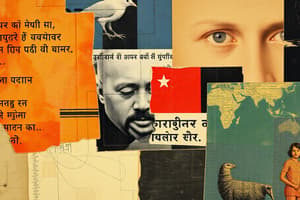Podcast
Questions and Answers
What is the official script used for writing Hindi?
What is the official script used for writing Hindi?
- Cyrillic script
- Arabic script
- Latin script
- Devanagari script (correct)
What type of word order does Hindi predominantly follow?
What type of word order does Hindi predominantly follow?
- Object-Subject-Verb
- Verb-Subject-Object
- Subject-Object-Verb (correct)
- Subject-Verb-Object
Which of the following dialects is Standard Hindi based on?
Which of the following dialects is Standard Hindi based on?
- Khariboli (correct)
- Awadhi
- Braj
- Bhojpuri
Which of the following best describes the grammatical features of Hindi nouns?
Which of the following best describes the grammatical features of Hindi nouns?
How does Hindi influence its vocabulary?
How does Hindi influence its vocabulary?
Flashcards are hidden until you start studying
Study Notes
Overview of Hindi
- Hindi is an Indo-Aryan language primarily spoken in India.
- It is one of the 22 scheduled languages of India and serves as an official language of the Indian government.
- Hindi is written in the Devanagari script.
Linguistic Classification
- Belongs to the Indo-European language family.
- Part of the Indic branch of the Indo-Iranian languages.
Dialects
- Numerous dialects, with Standard Hindi being based on the Khariboli dialect.
- Other dialects include Awadhi, Bhojpuri, and Braj.
Vocabulary
- Influenced by Sanskrit, Persian, Arabic, Turkish, and English.
- Rich in synonyms, often using Sanskrit roots for formal contexts and vernacular forms for colloquial speech.
Grammar
- Subject-Object-Verb (SOV) word order.
- Use of postpositions instead of prepositions.
- Nouns have gender (masculine and feminine) and can be singular or plural.
Phonetics
- Contains a wide range of consonants and vowels.
- Features aspirated sounds (e.g., 'p' vs. 'ph') which can change meanings.
Cultural Significance
- Hindi is a vehicle for literature, cinema (Bollywood), and music.
- Plays a crucial role in national identity and cultural expression in India.
Global Presence
- Hindi is spoken by over 500 million people worldwide.
- Significant diaspora communities in countries like the USA, Canada, and the UK.
Learning Resources
- Available language courses, textbooks, apps (e.g., Duolingo, Rosetta Stone).
- Hindi media (films, music, literature) serve as practical learning tools.
Writing System
- Devanagari consists of 11 vowels and 33 consonants.
- Each character represents a syllable, making it phonetic in nature.
Language Politics
- Hindi has been at the center of linguistic debates in India, particularly regarding language policy and regional identities.
- Criticism exists about its dominance over other regional languages.
Overview of Hindi
- Hindi is an Indo-Aryan language, predominantly spoken in India.
- Recognized as one of India's 22 scheduled languages and serves as an official language of the Indian government.
- Utilizes the Devanagari script for writing.
Linguistic Classification
- Part of the Indo-European language family.
- Falls under the Indic branch of Indo-Iranian languages.
Dialects
- Features various dialects, with Standard Hindi based on the Khariboli dialect.
- Other prominent dialects include Awadhi, Bhojpuri, and Braj.
Vocabulary
- Vocabulary influenced by multiple languages: Sanskrit, Persian, Arabic, Turkish, and English.
- Rich in synonyms, employing Sanskrit roots for formal contexts while using vernacular forms in everyday speech.
Grammar
- Displays a Subject-Object-Verb (SOV) word order.
- Utilizes postpositions as opposed to prepositions.
- Nouns are categorized by gender (masculine and feminine) and can vary between singular and plural forms.
Phonetics
- Characterized by a diverse range of consonants and vowels.
- Incorporates aspirated sounds, where variations (e.g., 'p' vs. 'ph') can alter meanings.
Cultural Significance
- Acts as a medium for literature, cinema (especially Bollywood), and music.
- Essential for national identity and cultural expression in India.
Global Presence
- Spoken by over 500 million individuals around the globe.
- Notable diaspora communities are found in countries like the USA, Canada, and the UK.
Learning Resources
- Various language courses, textbooks, and applications (such as Duolingo and Rosetta Stone) available for learners.
- Hindi media, including films, music, and literature, provide practical resources for language acquisition.
Writing System
- The Devanagari script includes 11 vowels and 33 consonants.
- Each character represents a syllable, resulting in a phonetic writing system.
Language Politics
- Hindi often emerges in linguistic debates regarding language policy and regional identities in India.
- There is criticism surrounding its perceived dominance over various regional languages.
Studying That Suits You
Use AI to generate personalized quizzes and flashcards to suit your learning preferences.




